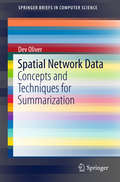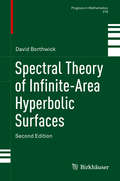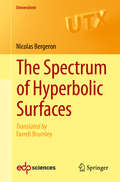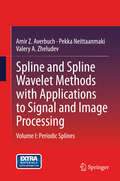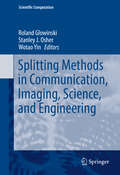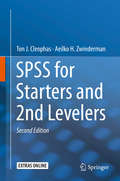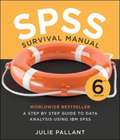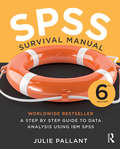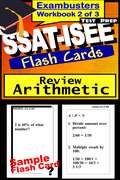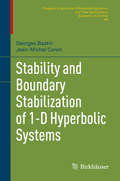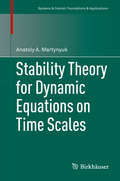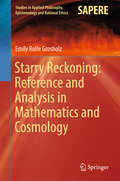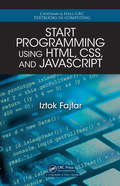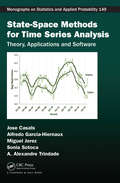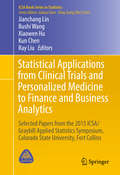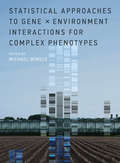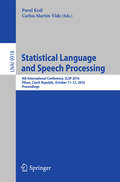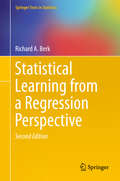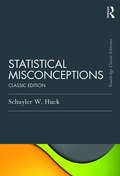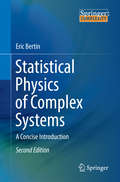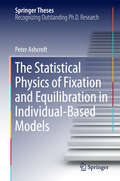- Table View
- List View
Spatial Network Data
by Dev OliverThis brief explores two of the main challenges of spatial network data analysis: the many connected components in the spatial network and the many candidates that have to be processed. Within this book, these challenges are conceptualized, well-defined problems are explored, and critical techniques are discussed. The process of summarizing spatial network data entails finding a compact description or representation of observations or activities on large spatial or spatiotemporal networks. However, summarizing spatial network data can be computationally challenging for various reasons, depending on the domain. The content has applications for professionals, organizations, and researchers in transportation safety, public safety, public health, disaster response, and related fields.
Special Functions and Orthogonal Polynomials
by Richard Beals Roderick WongThe subject of special functions is often presented as a collection of disparate results, rarely organized in a coherent way. This book emphasizes general principles that unify and demarcate the subjects of study. The authors' main goals are to provide clear motivation, efficient proofs, and original references for all of the principal results. The book covers standard material, but also much more. It shows how much of the subject can be traced back to two equations - the hypergeometric equation and confluent hypergeometric equation - and it details the ways in which these equations are canonical and special. There is extended coverage of orthogonal polynomials, including connections to approximation theory, continued fractions, and the moment problem, as well as an introduction to new asymptotic methods. There are also chapters on Meijer G-functions and elliptic functions. The final chapter introduces Painlevé transcendents, which have been termed the 'special functions of the twenty-first century'.
Spectral Theory of Infinite-Area Hyperbolic Surfaces
by David BorthwickThis text introduces geometric spectral theory in the context of infinite-area Riemann surfaces, providing a comprehensive account of the most recent developments in the field. For the second edition the context has been extended to general surfaces with hyperbolic ends, which provides a natural setting for development of the spectral theory while still keeping technical difficulties to a minimum. All of the material from the first edition is included and updated, and new sections have been added. Topics covered include an introduction to the geometry of hyperbolic surfaces, analysis of the resolvent of the Laplacian, scattering theory, resonances and scattering poles, the Selberg zeta function, the Poisson formula, distribution of resonances, the inverse scattering problem, Patterson-Sullivan theory, and the dynamical approach to the zeta function. The new sections cover the latest developments in the field, including the spectral gap, resonance asymptotics near the critical line, and sharp geometric constants for resonance bounds. A new chapter introduces recently developed techniques for resonance calculation that illuminate the existing results and conjectures on resonance distribution. The spectral theory of hyperbolic surfaces is a point of intersection for a great variety of areas, including quantum physics, discrete groups, differential geometry, number theory, complex analysis, and ergodic theory. This book will serve as a valuable resource for graduate students and researchers from these and other related fields. Review of the first edition: "The exposition is very clear and thorough, and essentially self-contained; the proofs are detailed. . . The book gathers together some material which is not always easily available in the literature. . . To conclude, the book is certainly at a level accessible to graduate students and researchers from a rather large range of fields. Clearly, the reader. . . would certainly benefit greatly from it. " (Colin Guillarmou, Mathematical Reviews, Issue 2008 h)
The Spectrum of Hyperbolic Surfaces
by Nicolas BergeronThistext is an introduction to the spectral theory of the Laplacian oncompact or finite area hyperbolic surfaces. For some of thesesurfaces, called "arithmetic hyperbolic surfaces", theeigenfunctions are of arithmetic nature, and one may use analytictools as well as powerful methods in number theory to study them. Afteran introduction to the hyperbolic geometry of surfaces, with aspecial emphasis on those of arithmetic type, and then anintroduction to spectral analytic methods on the Laplace operator onthese surfaces, the author develops the analogy between geometry(closed geodesics) and arithmetic (prime numbers) in proving theSelberg trace formula. Along with important number theoreticapplications, the author exhibits applications of these tools to thespectral statistics of the Laplacian and the quantum uniqueergodicity property. The latter refers to the arithmetic quantumunique ergodicity theorem, recently proved by Elon Lindenstrauss. Thefruit of several graduate level courses at Orsay and Jussieu, The Spectrum of Hyperbolic Surfaces allows the reader to review an array of classical results andthen to be led towards very active areas in modern mathematics.
Speech and Audio Processing: A MATLAB®-based Approach
by Ian Vince McloughlinWith this comprehensive and accessible introduction to the field, you will gain all the skills and knowledge needed to work with current and future audio, speech, and hearing processing technologies. Topics covered include mobile telephony, human-computer interfacing through speech, medical applications of speech and hearing technology, electronic music, audio compression and reproduction, big data audio systems and the analysis of sounds in the environment. All of this is supported by numerous practical illustrations, exercises, and hands-on MATLAB examples on topics as diverse as psychoacoustics (including some auditory illusions), voice changers, speech compression, signal analysis and visualisation, stereo processing, low-frequency ultrasonic scanning, and machine learning techniques for big data. With its pragmatic and application driven focus, and concise explanations, this is an essential resource for anyone who wants to rapidly gain a practical understanding of speech and audio processing and technology.
Spline and Spline Wavelet Methods with Applications to Signal and Image Processing
by Valery A. Zheludev Pekka Neittaanmäki Amir Z. AverbuchThis book presents various contributions of splines to signal and image processing from a unified perspective that is based on the Zak transform (ZT). It expands the methodology from periodic splines, which were presented in the first volume, to non-periodic splines. Together, these books provide a universal toolbox accompanied by MATLAB software for manipulating polynomial and discrete splines, spline-based wavelets, wavelet packets and wavelet frames for signal/ image processing applications. In this volume, we see that the ZT provides an integral representation of discrete and polynomial splines, which, to some extent, is similar to Fourier integral. The authors explore elements of spline theory and design, and consider different types of polynomial and discrete splines. They describe applications of spline-based wavelets to data compression. These splines are useful for real-time signal processing and, in particular, real-time wavelet and frame transforms. Further topics addressed in this volume include: "global" splines, such as interpolating, self-dual and smoothing, whose supports are infinite; the compactly supported quasi-interpolating and smoothing splines including quasi-interpolating splines on non-uniform grids; and cubic Hermite splines as a source for the design of multiwavelets and multiwavelet frames. Readers from various disciplines including engineering, computer science and mathematical information technology will find the descriptions of algorithms, applications and software in this book especially useful.
Splitting Methods in Communication, Imaging, Science, and Engineering
by Roland Glowinski Stanley J. Osher Wotao YinThis book is about computational methods based on operator-splitting. The three editors, while all being applied mathematicians whose expertise include splitting methods, work in different application areas including computational mechanics, image processing, wireless communication, nonlinear optics (optical fibers), and so on. Therefore, the book will present very versatile aspects of splitting methods and their applications, motivating the cross-fertilization of ideas.
Sports Research with Analytical Solution using SPSS
by J. P. VermaA step-by-step approach to problem-solving techniques using SPSS® in the fields of sports science and physical education Featuring a clear and accessible approach to the methods, processes, and statistical techniques used in sports science and physical education, Sports Research with Analytical Solution using SPSS® emphasizes how to conduct and interpret a range of statistical analysis using SPSS. The book also addresses issues faced by research scholars in these fields by providing analytical solutions to various research problems without reliance on mathematical rigor. Logically arranged to cover both fundamental and advanced concepts, the book presents standard univariate and complex multivariate statistical techniques used in sports research such as multiple regression analysis, discriminant analysis, cluster analysis, and factor analysis. The author focuses on the treatment of various parametric and nonparametric statistical tests, which are shown through the techniques and interpretations of the SPSS outputs that are generated for each analysis. Sports Research with Analytical Solution using SPSS® also features: Numerous examples and case studies to provide readers with practical applications of the analytical concepts and techniques Plentiful screen shots throughout to help demonstrate the implementation of SPSS outputs Illustrative studies with simulated realistic data to clarify the analytical techniques covered End-of-chapter short answer questions, multiple choice questions, assignments, and practice exercises to help build a better understanding of the presented concepts A companion website with associated SPSS data files and PowerPoint® presentations for each chapter Sports Research with Analytical Solution using SPSS® is an excellent textbook for upper-undergraduate, graduate, and PhD-level courses in research methods, kinesiology, sports science, medicine, nutrition, health education, and physical education. The book is also an ideal reference for researchers and professionals in the fields of sports research, sports science, physical education, and social sciences, as well as anyone interested in learning SPSS.
SPSS for Starters and 2nd Levelers
by Ton J. Cleophas Aeilko H. ZwindermanFor medical and health workers this book is a must-have, because statistical methods in these fields are vital, and no equivalent work is available. For medical and health students this is equally true. A unique point is its low threshold, textually simple and at the same time full of self-assessment opportunities. Other unique points are the succinctness of the chapters with 3 to 6 pages, the presence of entire-commands-texts of the statistical methodologies reviewed and the fact that dull scientific texts imposing an unnecessary burden on busy and jaded professionals have been left out. For readers requesting more background, theoretical and mathematical information a note section with references is in each chapter. The first edition in 2010 was the first publication of a complete overview of SPSS methodologies for medical and health statistics. Well over 100,000 copies of various chapters were sold within the first year of publication. Reasons for a rewrite were four. First, many important comments from readers urged for a rewrite. Second, SPSS has produced many updates and upgrades, with relevant novel and improved methodologies. Third, the authors felt that the chapter texts needed some improvements for better readability: chapters have now been classified according the outcome data helpful for choosing your analysis rapidly, a schematic overview of data, and explanatory graphs have been added. Fourth, current data are increasingly complex and many i mportant methods for analysis were missing in the first edition. For that latter purpose some more advanced methods seemed unavoidable, like hierarchical loglinear methods, gamma and Tweedie regressions and random intercept analyses. In order for the contents of the book to remain covered by the title, the authors renamed the book: SPSS for Starters and 2nd Levelers. Special care was, nonetheless, taken to keep things as simple as possible. Medical and health professionals tend to dislike software syntax. Therefore, virtually no syntax, but, rather, simple menu commands are given. The arithmetic is still of a no-more-than high-school level. Step-by-step analyses of different statistical methodologies are given with the help of 60 SPSS data files available through the internet. Because of the lack of time of this busy group of people, the authors have given every effort to produce a text as succinct as possible.
SPSS Survival Manual: A Step By Step Guide to Data Analysis Using IBM SPSS
by Julie PallantThe SPSS Survival Manual throws a lifeline to students and researchers grappling with this powerful data analysis software. In her bestselling guide, Julie Pallant guides you through the entire research process, helping you choose the right data analysis technique for your project. From the formulation of research questions, to the design of the study and analysis of data, to reporting the results, Julie discusses basic and advanced statistical techniques. She outlines each technique clearly, with step- by-step procedures for performing the analysis, a detailed guide to interpreting data output and an example of how to present the results in a report. For both beginners and experienced users in psychology, sociology, health sciences, medicine, education, business and related disciplines, the SPSS Survival Manual is an essential text. Illustrated with screen grabs, examples of output and tips, it is supported by a website with sample data and guidelines on report writing. This sixth edition is fully revised and updated to accommodate changes to IBM SPSS procedures, screens and output. It covers new SPSS tools for generating graphs and non-parametric statistics, importing data, and calculating dates.
SPSS Survival Manual: A step by step guide to data analysis using IBM SPSS
by Julie PallantThe SPSS Survival Manual throws a lifeline to students and researchers grappling with this powerful data analysis software.In her bestselling guide, Julie Pallant guides you through the entire research process, helping you choose the right data analysis technique for your project. From the formulation of research questions, to the design of the study and analysis of data, to reporting the results, Julie discusses basic and advanced statistical techniques. She outlines each technique clearly, with step-by-step procedures for performing the analysis, a detailed guide to interpreting data output and an example of how to present the results in a report.For both beginners and experienced users in psychology, sociology, health sciences, medicine, education, business and related disciplines, the SPSS Survival Manual is an essential text. Illustrated with screen grabs, examples of output and tips, it is supported by a website with sample data and guidelines on report writing.This sixth edition is fully revised and updated to accommodate changes to IBM SPSS procedures, screens and output. It covers new SPSS tools for generating graphs and non- parametric statistics, importing data, and calculating dates.'An excellent introduction to using SPSS for data analysis. It provides a self-contained resource itself, with more than simply (detailed and clear) step-by-step descriptions of statistical procedures in SPSS. There is also a wealth of tips and advice, and for each statistical technique a brief, but consistently reliable, explanation is provided.' - Associate Professor George Dunbar, University of Warwick'This book is recommended as ESSENTIAL to all students completing research projects - minor and major.' - Dr John Roodenburg, Monash University
SSAT-ISEE Test Prep Flash Cards: Arithmetic (Exambusters SAT-ISEE Workbook #2 of 3)
by Ace Inc.<P><P><i>Advisory: Bookshare has learned that this book offers only partial accessibility. We have kept it in the collection because it is useful for some of our members. Benetech is actively working on projects to improve accessibility issues such as these.</i><P><P> "SSAT-ISEE Prep Flashcard Workbook 2: ARITHMETIC REVIEW" 600 questions and answers highlight essential arithmetic definitions, problems, and concepts. Topics: Addition, Subtraction, Multiplication, and Division of Whole Numbers; Fractions and Decimals, Multiplication Tables, Word Problems, Percents, Measurement, Metric System, Square Roots and Powers, Real Numbers, Properties of Numbers <P>EXAMBUSTERS SSAT and ISEE Prep Workbooks provide comprehensive, fundamental SSAT and ISEE review--one fact at a time--to prepare students to take practice SSAT and ISEE tests. Each SSAT and ISEE study guide focuses on one specific subject area covered on the SSAT and ISEE exams. From 300 to 600 questions and answers, each volume in the SSAT and ISEE series is a quick and easy, focused read. Reviewing SSAT and ISEE flash cards is the first step toward more confident SSAT and ISEE preparation and ultimately, higher SSAT and ISEE exam scores!
Stability and Boundary Stabilization of 1-D Hyperbolic Systems
by Georges Bastin Jean-Michel CoronThis monograph explores the modeling of conservation and balance laws of one-dimensional hyperbolic systems using partial differential equations. It presents typical examples of hyperbolic systems for a wide range of physical engineering applications, allowing readers to understand the concepts in whichever setting is most familiar to them. With these examples, it also illustrates how control boundary conditions may be defined for the most commonly used control devices. The authors begin with the simple case of systems of two linear conservation laws and then consider the stability of systems under more general boundary conditions that may be differential, nonlinear, or switching. They then extend their discussion to the case of nonlinear conservation laws and demonstrate the use of Lyapunov functions in this type of analysis. Systems of balance laws are considered next, starting with the linear variety before they move on to more general cases of nonlinear ones. They go on to show how the problem of boundary stabilization of systems of two balance laws by both full-state and dynamic output feedback in observer-controller form is solved by using a "backstepping" method, in which the gains of the feedback laws are solutions of an associated system of linear hyperbolic PDEs. The final chapter presents a case study on the control of navigable rivers to emphasize the main technological features that may occur in real live applications of boundary feedback control. Stability and Boundary Stabilization of 1-D Hyperbolic Systems will be of interest to graduate students and researchers in applied mathematics and control engineering. The wide range of applications it discusses will help it to have as broad an appeal within these groups as possible.
Stability Theory for Dynamic Equations on Time Scales
by Anatoly A. MartynyukThis monograph is a first in the world to present three approaches for stability analysis of solutions of dynamic equations. The first approach is based on the application of dynamic integral inequalities and the fundamental matrix of solutions of linear approximation of dynamic equations. The second is based on the generalization of the direct Lyapunovs method for equations on time scales, using scalar, vector and matrix-valued auxiliary functions. The third approach is the application of auxiliary functions (scalar, vector, or matrix-valued ones) in combination with differential dynamic inequalities. This is an alternative comparison method, developed for time continuous and time discrete systems. In recent decades, automatic control theory in the study of air- and spacecraft dynamics and in other areas of modern applied mathematics has encountered problems in the analysis of the behavior of solutions of time continuous-discrete linear and/or nonlinear equations of perturbed motion. In the book "Men of Mathematics," 1937, E. T. Bell wrote: "A major task of mathematics today is to harmonize the continuous and the discrete, to include them in one comprehensive mathematics, and to eliminate obscurity from both. " Mathematical analysis on time scales accomplishes exactly this. This research has potential applications in such areas as theoretical and applied mechanics, neurodynamics, mathematical biology and finance among others.
Starry Reckoning: Reference and Analysis in Mathematics and Cosmology
by Emily Rolfe GrosholzThis book deals with a topic that has been largely neglected by philosophers of science to date: the ability to refer and analyze in tandem. On the basis of a set of philosophical case studies involving both problems in number theory and issues concerning time and cosmology from the era of Galileo, Newton and Leibniz up through the present day, the author argues that scientific knowledge is a combination of accurate reference and analytical interpretation. In order to think well, we must be able to refer successfully, so that we can show publicly and clearly what we are talking about. And we must be able to analyze well, that is, to discover productive and explanatory conditions of intelligibility for the things we are thinking about. The book's central claim is that the kinds of representations that make successful reference possible and those that make successful analysis possible are not the same, so that significant scientific and mathematical work typically proceeds by means of a heterogeneous discourse that juxtaposes and often superimposes a variety of kinds of representation, including formal and natural languages as well as more iconic modes. It demonstrates the virtues and necessity of heterogeneity in historically central reasoning, thus filling an important gap in the literature and fostering a new, timely discussion on the epistemology of science and mathematics.
Start Programming Using HTML, CSS, and JavaScript (Chapman & Hall/CRC Textbooks in Computing)
by Iztok FajfarThis text is a manual for undergraduate students in engineering and the natural sciences to discover how computer programming works. Using a dialog format between two students and a professor, the text teaches students how the mainstream web languages HTML, CSS, and JavaScript interact and how to harness their capabilities in practical settings. Each chapter focuses on a specific theme supported by a gradual development of engaging worked examples of live web documents and applications using the three languages.
State-Space Methods for Time Series Analysis: Theory, Applications and Software (Chapman & Hall/CRC Monographs on Statistics and Applied Probability)
by Jose Casals Alfredo Garcia-Hiernaux Miguel Jerez Sonia Sotoca A. Alexandre TrindadeThe state-space approach provides a formal framework where any result or procedure developed for a basic model can be seamlessly applied to a standard formulation written in state-space form. Moreover, it can accommodate with a reasonable effort nonstandard situations, such as observation errors, aggregation constraints, or missing in-sample values. Exploring the advantages of this approach, State-Space Methods for Time Series Analysis: Theory, Applications and Software presents many computational procedures that can be applied to a previously specified linear model in state-space form. After discussing the formulation of the state-space model, the book illustrates the flexibility of the state-space representation and covers the main state estimation algorithms: filtering and smoothing. It then shows how to compute the Gaussian likelihood for unknown coefficients in the state-space matrices of a given model before introducing subspace methods and their application. It also discusses signal extraction, describes two algorithms to obtain the VARMAX matrices corresponding to any linear state-space model, and addresses several issues relating to the aggregation and disaggregation of time series. The book concludes with a cross-sectional extension to the classical state-space formulation in order to accommodate longitudinal or panel data. Missing data is a common occurrence here, and the book explains imputation procedures necessary to treat missingness in both exogenous and endogenous variables. Web ResourceThe authors’ E4 MATLAB® toolbox offers all the computational procedures, administrative and analytical functions, and related materials for time series analysis. This flexible, powerful, and free software tool enables readers to replicate the practical examples in the text and apply the procedures to their own work.
Statistical Applications from Clinical Trials and Personalized Medicine to Finance and Business Analytics
by Jianchang Lin Bushi Wang Xiaowen Hu Kun Chen Ray LiuThe papers in this volume represent a broad, applied swath of advanced contributions to the 2015 ICSA/Graybill Applied Statistics Symposium of the International Chinese Statistical Association, held at Colorado State University in Fort Collins. The contributions cover topics that range from statistical applications in business and finance to applications in clinical trials and biomarker analysis. Each papers was peer-reviewed by at least two referees and also by an editor. The conference was attended by over 400 participants from academia, industry, and government agencies around the world, including from North America, Asia, and Europe.
Statistical Approaches to Gene x Environment Interactions for Complex Phenotypes
by Michael WindleDiverse methodological and statistical approaches for investigating the role of gene-environment interactions in a range of complex diseases and traits. Findings from the Human Genome Project and from Genome-Wide Association (GWA) studies indicate that many diseases and traits manifest a more complex genomic pattern than previously assumed. These findings, and advances in high-throughput sequencing, suggest that there are many sources of influence—genetic, epigenetic, and environmental. This volume investigates the role of the interactions of genes and environment (G × E) in diseases and traits (referred to by the contributors as complex phenotypes) including depression, diabetes, obesity, and substance use. The contributors first present different statistical approaches or strategies to address G × E and G × G interactions with high-throughput sequenced data, including two-stage procedures to identify G × E and G × G interactions, marker-set approaches to assessing interactions at the gene level, and the use of a partial-least square (PLS) approach. The contributors then turn to specific complex phenotypes, research designs, or combined methods that may advance the study of G × E interactions, considering such topics as randomized clinical trials in obesity research, longitudinal research designs and statistical models, and the development of polygenic scores to investigate G × E interactions. Contributors Fatima Umber Ahmed, Yin-Hsiu Chen, James Y. Dai, Caroline Y. Doyle, Zihuai He, Li Hsu, Shuo Jiao, Erin Loraine Kinnally, Yi-An Ko, Charles Kooperberg, Seunggeun Lee, Arnab Maity, Jeanne M. McCaffery, Bhramar Mukherjee, Sung Kyun Park, Duncan C. Thomas, Alexandre Todorov, Jung-Ying Tzeng, Tao Wang, Michael Windle, Min Zhang
Statistical Language and Speech Processing: 4th International Conference, SLSP 2016, Pilsen, Czech Republic, October 11-12, 2016, Proceedings (Lecture Notes in Computer Science #9918)
by Pavel Král Carlos Martín-VideThis book constitutes the refereed proceedings of the 4th International Conference on Statistical Language and Speech Processing, SLSP 2016, held in Pilsen, Czech Republic, in October 2016. The 11 full papers presented together with two invited talks were carefully reviewed and selected from 38 submissions. The papers cover topics such as anaphora and coreference resolution; authorship identification, plagiarism and spam filtering; computer-aided translation; corpora and language resources; data mining and semantic web; information extraction; information retrieval; knowledge representation and ontologies; lexicons and dictionaries; machine translation; multimodal technologies; natural language understanding; neural representation of speech and language; opinion mining and sentiment analysis; parsing; part-of-speech tagging; question and answering systems; semantic role labeling; speaker identification and verification; speech and language generation; speech recognition; speech synthesis; speech transcription; speech correction; spoken dialogue systems; term extraction; text categorization; test summarization; user modeling.
Statistical Learning from a Regression Perspective
by Richard A. BerkThis textbook considers statistical learning applications when interest centers on the conditional distribution of the response variable, given a set of predictors, and when it is important to characterize how the predictors are related to the response. As a first approximation, this can be seen as an extension of nonparametric regression. This fully revised new edition includes important developments over the past 8 years. Consistent with modern data analytics, it emphasizes that a proper statistical learning data analysis derives from sound data collection, intelligent data management, appropriate statistical procedures, and an accessible interpretation of results. A continued emphasis on the implications for practice runs through the text. Among the statistical learning procedures examined are bagging, random forests, boosting, support vector machines and neural networks. Response variables may be quantitative or categorical. As in the first edition, a unifying theme is supervised learning that can be treated as a form of regression analysis. Key concepts and procedures are illustrated with real applications, especially those with practical implications. A principal instance is the need to explicitly take into account asymmetric costs in the fitting process. For example, in some situations false positives may be far less costly than false negatives. Also provided is helpful craft lore such as not automatically ceding data analysis decisions to a fitting algorithm. In many settings, subject-matter knowledge should trump formal fitting criteria. Yet another important message is to appreciate the limitation of one's data and not apply statistical learning procedures that require more than the data can provide. The material is written for upper undergraduate level and graduate students in the social and life sciences and for researchers who want to apply statistical learning procedures to scientific and policy problems. The author uses this book in a course on modern regression for the social, behavioral, and biological sciences. Intuitive explanations and visual representations are prominent. All of the analyses included are done in R with code routinely provided.
Statistical Methodologies with Medical Applications
by Poduri Srs RaoThis book presents the methodology and applications of a range of important topics in statistics, and is designed for graduate students in Statistics and Biostatistics and for medical researchers. Illustrations and more than ninety exercises with solutions are presented. They are constructed from the research findings of the medical journals, summary reports of the Centre for Disease Control (CDC) and the World Health Organization (WHO), and practical situations. The illustrations and exercises are related to topics such as immunization, obesity, hypertension, lipid levels, diet and exercise, harmful effects of smoking and air pollution, and the benefits of gluten free diet. This book can be recommended for a one or two semester graduate level course for students studying Statistics, Biostatistics, Epidemiology and Health Sciences. It will also be useful as a companion for medical researchers and research oriented physicians.
Statistical Misconceptions: Classic Edition (Psychology Press & Routledge Classic Editions)
by Schuyler W. HuckThis engaging book helps readers identify and then discard 52 misconceptions about data and statistical summaries. The focus is on major concepts contained in typical undergraduate and graduate courses in statistics, research methods, or quantitative analysis. Interactive Internet exercises that further promote undoing the misconceptions are found on the book's website. The author’s accessible discussion of each misconception has five parts: The Misconception - a brief description of the misunderstanding Evidence that the Misconception Exists – examples and claimed prevalence Why the Misconception is Dangerous – consequence of having the misunderstanding Undoing the Misconception - how to think correctly about the concept Internet Assignment - an interactive activity to help readers gain a firm grasp of the statistical concept and overcome the misconception. The book's statistical misconceptions are grouped into 12 chapters that match the topics typically taught in introductory/intermediate courses. However, each of the 52 discussions is self-contained, thus allowing the misconceptions to be covered in any order without confusing the reader. Organized and presented in this manner, the book is an ideal supplement for any standard textbook. An ideal supplement for undergraduate and graduate courses in statistics, research methods, or quantitative analysis taught in psychology, education, business, nursing, medicine, and the social sciences. The book also appeals to independent researchers interested in undoing their statistical misconceptions.
Statistical Physics of Complex Systems
by Eric BertinThis course-tested primer provides graduate students and non-specialists with a basic understanding of the concepts and methods of statistical physics and demonstrates their wide range of applications to interdisciplinary topics in the field of complex system sciences, including selected aspects of theoretical modeling in biology and the social sciences. Generally speaking, the goals of statistical physics may be summarized as follows: on the one hand to study systems composed of a large number of interacting units, and on the other to predict the macroscopic, collective behavior of the system considered from the perspective of the microscopic laws governing the dynamics of the individual entities. These two goals are essentially also shared by what is now called 'complex systems science,' and as such, systems studied in the framework of statistical physics may be considered to be among the simplest examples of complex systems - while also offering a rather well developed mathematical treatment. The second edition has been significantly revised and expanded, featuring in particular three new chapters addressing non-conserved particles, evolutionary population dynamics, networks, properties of both individual and coupled simple dynamical systems, and convergence theorems, as well as short appendices that offer helpful hints on how to perform simple stochastic simulations in practice. Yet, the original spirit of the book - to remain accessible to a broad, non-specialized readership - has been kept throughout: the format is a set of concise, modular and self-contained topical chapters, avoiding technicalities and jargon as much as possible, and complemented by a wealth of worked-out examples, so as to make this work useful as a self-study text or as textbook for short courses. From the reviews of the first edition: ". . . a good introduction to basic concepts of statistical physics and complex systems for students and researchers with an interest in complex systems in other fields . . . . " Georg Hebermehl, Zentralblatt MATH, Vol. 1237, 2012 ". . . this short text remains very refreshing for the mathematician. " Dimitri Petritis, Mathematical Reviews, Issue 2012k
The Statistical Physics of Fixation and Equilibration in Individual-Based Models
by Peter AshcroftThis thesis explores several interdisciplinary topics at the border of theoretical physics and biology, presenting results that demonstrate the power of methods from statistical physics when applied to neighbouring disciplines. From birth-death processes in switching environments to discussions on the meaning of quasi-potential landscapes in high-dimensional spaces, this thesis is a shining example of the efficacy of interdisciplinary research. The fields advanced in this work include game theory, the dynamics of cancer, and invasion of mutants in resident populations, as well as general contributions to the theory of stochastic processes. The background material provides an intuitive introduction to the theory and applications of stochastic population dynamics, and the use of techniques from statistical physics in their analysis. The thesis then builds on these foundations to address problems motivated by biological phenomena.
